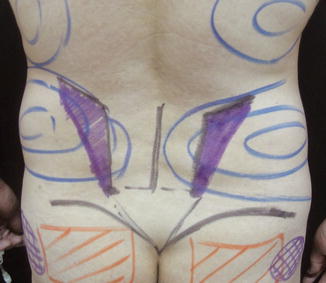and Peter M. Prendergast2
(1)
Elysium Aesthetics, Bogota, Colombia
(2)
Venus Medical, Dublin, Ireland
Introduction
The shape, size, and definition of the back play an important role in the aesthetics of the male human anatomy [1, 2]. Ideally, the posterior torso should be “V” shaped, broader superiorly, and tapering inferiorly. The deltoid volume should be pronounced and there should be visible separation between these muscles and the rest of the back [3]. With underdeveloped musculature and excess fatty deposits around the flanks and waist, definition is poor and the ideal shape becomes an inverted “V” or pear shape. In men, fat deposits around the posterior and lateral waist, the so-called love handles, are particularly problematic because they often do not respond to exercise and dieting [4]. The main objective of body sculpting in the back is to obtain the “V”-shaped posterior torso. This is achieved by thorough liposculpture to extract most of the fat and highlight the dominant muscles, particularly the latissimus dorsi and paraspinal muscles (Fig. 11.1) [5–7].
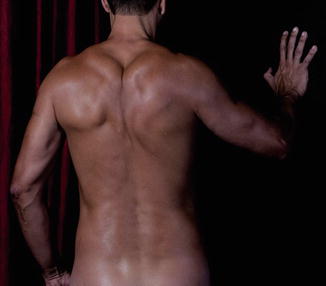

Fig. 11.1
Athletic male torso showing the ideal “V” shape
Stealth Incisions
Extensive lipoplasty of the posterior aspect of the torso requires incision sites that allow access to most of the surface area of the back and flanks. Placing incisions on almost any point over the surface of the back poses the risk of visibility, so we use stealth incisions to hide them. Incisions are placed in the posterior axillary folds and in the intergluteal crease.
For accessing the entire treatment area from these limited incisions, specially designed long and curved cannulae are used. These allow access to the flanks and upper and lower back and follow the curvature of the torso and lower back as the sculpting progresses laterally (Fig. 11.2).
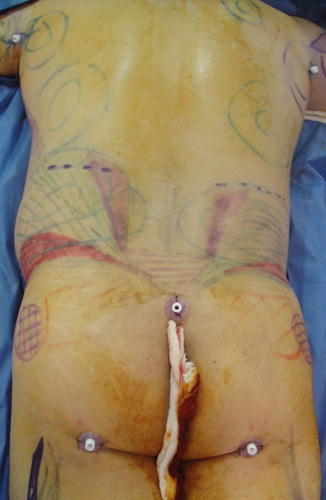

Fig. 11.2
Intraoperative image showing the preferred incision and port sites
The Use of Drains
A single drain is used in the posterior torso in the intergluteal incision. Open drainage is useful for very mobile patients who prefer not to be restricted, although it is messier and requires the concomitant use of diapers or highly absorbent dressings or pads (Fig. 11.3).
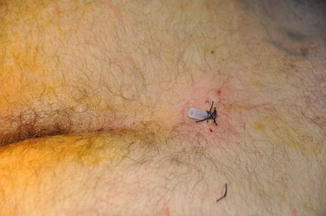

Fig. 11.3
Open drain in sacral incision
Closed drains are more bulky and difficult to conceal. Although they tend to be more cumbersome with the foam vest and garment, their potential benefits should be discussed with the patient preoperatively. The vacuum generated may improve skin redraping. Naturally, they also contain much of the blood-stained drainage fluid.
Markings
Deep Markings
The initial liposuction markings are made in the areas where extra fat is located (Fig. 11.4): the axillary fat pad, the mid back where the fat rolls are located in some patients, and the lower back over the hips (love handles). The latter area is often under-resected, leading to a suboptimal result, particularly if the patient gains any weight subsequently (Fig. 11.5). The key in this important area is to thoroughly remove the fat in order to achieve the desired shape and provide a long-lasting result.
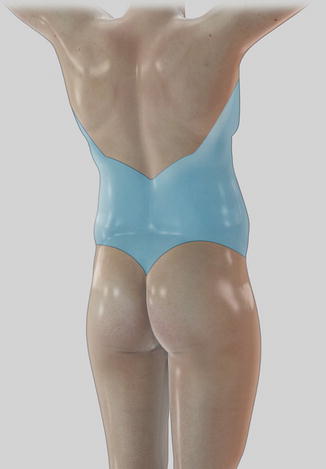
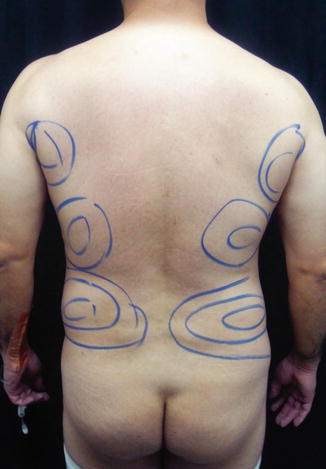

Fig. 11.4
Illustration showing the areas requiring debulking of extra fat (in light blue)

Fig. 11.5
Marking of the axillary fat pad, mid back, and love handles
Framing
Framing delineates the position of the muscles and other superficial anatomy landmarks. In the upper back, the lateral border of the latissimus dorsi is outlined, although most of the definition of this muscle is achieved with the patient in the supine position. In practice, some definition of the upper back muscles is achieved simply by removing superfluous fat. It is not necessary to mark and sculpt the smaller muscles like trapezius and rhomboids. Attempting to define these muscles individually tends to produce an unnatural result.
The lower back is different. The important muscles to reveal are the paralumbar muscles, paired columns of muscle adjacent to the lower spine [3]. The lines formed by these create a hollow area lateral to them when the love handles are empty. These continue inferiorly with the sacral dimples (Fig. 11.6). In some men the sacral dimples are visible, but they are not key features that determine an athletic shape, since men do not tend to have an appreciable sacral fat pad.
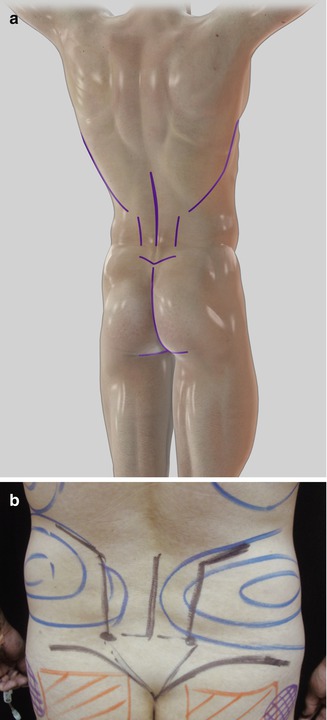

Fig. 11.6
(a) Framing the latissimus dorsi and paralumbar muscles (b) preoperative markings to define the paralumbar muscles
Negative Spaces
There are three key areas for negative spaces in men: one is a triangular-shaped area lateral to the paralumbar muscles, with an upper limit along the lower costal margin (Fig. 11.7).

